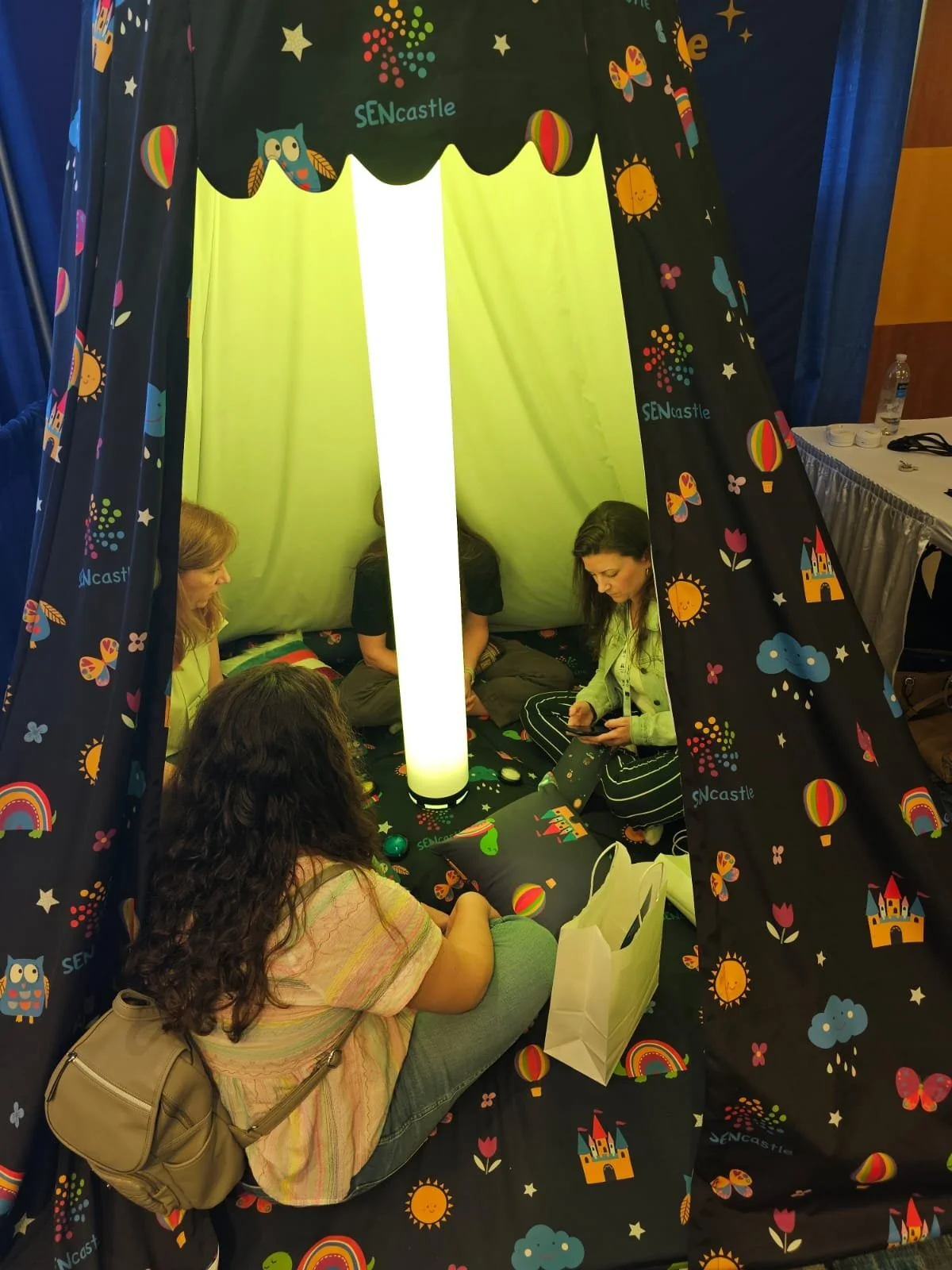Integration of SENcastle into a Sensory Room: Approaches, Benefits, and Added Value in Different Institutions
The Power of Sensory Rooms in Developmental Support
Sensory rooms are specialised, multisensory environments designed to provide controlled sensory input to individuals with neurodiversity. Children and adults with developmental disorders, such as ASD, ADHD, intellectual disabilities, cerebral palsy, or sensory integration disorders, often struggle with processing and interpreting sensory stimuli from their environment, which affects their behaviour, attention, emotional regulation, and learning ability. A sensory room provides a space where users can experience a range of sensory stimuli (visual, auditory, tactile, vestibular, proprioceptive, gustatory, and olfactory) in a safe and structured environment. According to Ayres (2005), such sensory stimulation contributes to improved neurological organisation and the development of adaptive responses, i.e., behaviours that are functional, purposeful, and socially appropriate. Given the increasing number of children with developmental difficulties in educational and therapeutic institutions, sensory rooms are becoming an increasingly important tool for inclusion, support, and ensuring the progress of each user.
SENcastle as a Central Multisensory Element
SENcastle represents an innovative and multifunctional element of a sensory room that integrates light, sound, vibration, and tactile stimuli. Unlike traditional sensory elements that primarily offer passive sensory input, SENcastle enables active user engagement, whether through activating content using sensory cards, adjusting stimuli based on personal preferences, or interacting with others. Its modularity allows professionals, therapists, and parents to tailor the content to the individual needs of the user, whether for calming, encouraging participation in activities, learning new concepts, or developing communication. In practice, SENcastle can be used as a starting point when a user enters the sensory room, a central hub for group activities, or as an individual tool for self-regulation.
Complementing and Enhancing Existing Equipment
One of the significant advantages of SENcastle is its ability to integrate with existing equipment in a sensory room. It can be connected to fibre optics for additional visual effects, tactile panels and paths that encourage touch and exploration of textures, as well as swings and trampolines that provide vestibular stimulation. What sets it apart is its ability to simultaneously engage multiple senses, making it easier for children to participate in sensory-demanding activities.For example, children who have aversions to certain textures may better tolerate tactile challenges when accompanied by background music from SENcastle—the music serves as a form of distraction, shifting their focus from the texture to a pleasant auditory experience. SENcastle can also be incorporated into a sensory obstacle course, where a child might first need to overcome specific challenges or crawl through a tunnel before reaching the SENcastle. In this way, children are motivated to move, explore, and engage their bodies.
Individualised and Group Regulation Support
Self-regulation of sensory integration is crucial for participating in everyday activities, learning, and social interactions. SENcastle enables users to independently manage the amount, type, and intensity of sensory input, fostering the development of emotional awareness and behavioural control. This is particularly valuable for individuals who struggle with transitions between activities, experience sensory overload, or have difficulty sustaining attention.
SENcastle also supports group activities that emphasise shared decision-making and cooperation. According to Bialer and Miller (2011), integrating sensory, motor, and cognitive stimulation directly contributes to the development of organised behaviour, positively influencing every aspect of a child’s functioning.
Institutional Flexibility and Versatile Applications
The flexibility of SENcastle allows it to be adapted to various institutional contexts. In kindergartens, it is used to encourage independent play, establish routines, and support the development of emotional self-regulation. In primary schools, it serves as a tool for inclusive practice, assisting children with attention deficits and challenging behaviours, particularly during breaks or as part of individualised education programs. Rehabilitation centres use SENcastle for therapeutic interventions that can be tailored to multiple users within a single sensory room. Associations and day centres use it for relaxation activities, promoting social interaction, and reducing anxiety. In clinical practice, multisensory elements such as SENcastle are increasingly incorporated into occupational therapy and speech therapy to support the development of attention, speech, and motor skills (Case-Smith & O’Brien, 2014).
Promoting Cognitive, Motor, and Social Development
SENcastle offers a rich variety of content that can be used to support the development of multiple domains. Gross and fine motor activities can be paired with visual and auditory prompts from SENcastle; recorded messages or animal sound effects can serve as speech stimuli, while educational sensory cards can aid in concept acquisition, time orientation, and understanding cause-and-effect relationships. For children with difficulties in social skills, SENcastle offers a structured environment for learning appropriate behaviour, recognising emotions, and understanding others’ reactions. Auditory content and music further contribute to emotional regulation and increase motivation for participation, aligning with Dunn’s (2001) findings on the importance of auditory stimulation in the development of attention and behaviour.
SENcastle as a Future Standard in Sensory Integration
SENcastle goes beyond the role of an accessory and becomes a key element of every modern sensory room, introducing a new dimension of interactivity, user control, and content integration. Its versatility allows it to be implemented across various types of institutions, tailored to specific therapeutic and educational goals.
As a tool that surpasses traditional sensory stimulation, SENcastle promotes active self-regulation, motivation, engagement, and the ability to track therapeutic progress. In an era of growing awareness about the importance of individualised approaches, SENcastle emerges as the future standard in sensory integration. This tool empowers users while simultaneously supporting professionals in planning activities and applying them flexibly according to institutional goals.
References:
Ayres, A. J. (2005): Sensory Integration and the Child. Los Angeles: Western Psychological Services.
Schaaf, R. C., & Mailloux, Z. (2015): Clinician’s Guide for Implementing Ayres Sensory Integration: Promoting Participation for Children with Autism. AOTA Press.
Bialer, D., & Miller, L. J. (2011): No Longer A SECRET: Unique Common Sense Strategies for Children with Sensory or Motor Challenges. TherapyWorks.
Dunn, W. (2001): The Sensory Profile: User’s Manual. San Antonio: Psychological Corporation.
Case-Smith, J., & O’Brien, J. C. (2014): Occupational Therapy for Children and Adolescents. St. Louis: Elsevier.




